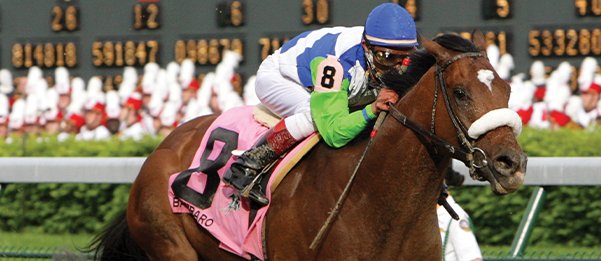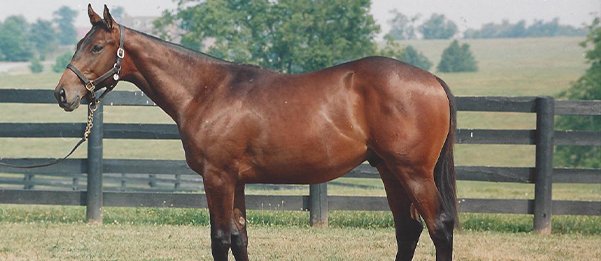The Essentials of Mating, Breeding, and Buying a Thoroughbred Racehorse
When my grandmother, Alice Chandler, would stand on a toilet seat to peek through a window to observe and verify physical matings, it was an act of necessity. In the 1960s and 70s, it was frowned upon for women—regardless of their status as owners of the horses and the farm—to witness matings. However, Gran Alice wasn’t content to sit on the sidelines and take a report from anyone else. She needed to see it for herself.
When her father, Hal Price Headley, passed in 1962, he gifted her four mares and 286 acres of the 4,000-acre Beaumont Farm. With this, she created Mill Ridge Farm, and in 1968 she became the first American to breed and sell an Epsom Derby winner, Sir Ivor, a horse descended from Alcibiades, a champion bred by Chandler’s father in 1927. Raymond Guest, an American businessman and U.S. Ambassador to Ireland, purchased Ivor at Keeneland in 1966 for $42,000. A Grade 1 winning two-year-old and Champion three-year-old in Europe, Sir Ivor influenced a shift in horse sales, emphasizing the U.S. commercial market and Keeneland, specifically. From there Alice Chandler continued to cement her legacy in Kentucky thoroughbred lore.
Alice Chandler with a mare and her foal at Mill Ridge Farm.
She had a legacy of thoroughbred breeding in her family bloodline and passed those experiences on to her children and to me, one of her grandchildren. When buying a thoroughbred racehorse, it’s important to know what makes a horse a thoroughbred and how thoroughbred bloodlines and matings shape the sport we love today.
The Importance of “Live Cover”
Thoroughbreds’ offspring must be the result of a “live cover” to be registered as a thoroughbred. The Jockey Club, the governing body for thoroughbred breeding, forbids registering foals conceived by artificial insemination or embryo transfer. While most breeds do not require a live cover for registration, the centuries-old rule—established by English Royalty in the 1700s—was implemented to help keep thoroughbred bloodlines pure and definable.
The Live Cover Process
The live cover process begins with a thorough examination of the broodmare—a mare used for breeding. Farm managers, like Marc and Lori here at Mill Ridge, observe a broodmare’s behavior throughout her 21-day ovulation cycle. During her cycle, a mare is introduced, or “teased,” to a stallion known as a teaser so that her response to him can be observed. Once the broodmare accepts his presence and the stallion shows signs of curiosity, a veterinarian checks her follicles to measure how close she is to ovulating. If the mare isn’t close, she won’t accept a stallion—she’ll whinny to make it clear she has no interest in him. If that happens, the stallion will be reintroduced a few days later to see how her cycle has advanced. The veterinarian will also conduct ultrasounds to determine the optimal date and time for the best chance of conception.
Once the mare is about to ovulate, she is taken to the breeding shed at the farm where the stallion resides. At the stallion farm, the mare is introduced to a new teaser to demonstrate to the stallion farm managers that she is close to ovulating and ready to accept a stallion. Finally, the stallion chosen to breed the mare is brought to the breeding shed and cleaned. The stallion is walked up behind the mare, and—if all previous steps have been successful—he mounts her. This is called the “live cover”, and the process only takes a few minutes. With the live cover complete, both horses are cleaned and returned home.
Pedigree, intelligence, and athleticism all combine to make a racehorse.
The Window of Opportunity is Small
North American stallion sheds are generally open between February 15 and June 15. A broodmare’s cycle naturally occurs in the spring, and we have built our season around this pattern.
To maintain divisions, the Jockey Club determined decades ago that all thoroughbreds in the northern hemisphere would have the same January 1 “birthday.” This means that regardless of when a foal is born, it will turn a year older on January 1st. Horses carry their foals for 340-360 days—around 11 months—and breeding is strategically planned to ensure that mares foal between January and May. If you breed a mare too early, the foal may be born in December and will turn 1 on January 1st. If you breed a mare too late, the foal will not be born until June and will be significantly younger than its competition.
A horse’s cycle is shorter than a human’s. The average length is three weeks. The mare will be about to ovulate for about five days during each cycle. This only leaves a few opportunities from February to mid-June for the broodmare to be covered.
Mill Ridge Farm has a strong legacy of thoroughbred breeding.
Planning a mating requires experience as well as the application of science. Determining which broodmare is a good match for a particular stallion requires research and data. Those putting together mating plans have access to a wide variety of data.
Success
After the pairing is done, success at the track four years later determines whether the mating will be considered a successful one. Mill Ridge has a proud history with 36 Grade I winners since 2000—a true indicator of our longstanding success.
Conformation
Conformation—the overall makeup of a horse—is the single most important factor to consider when evaluating racehorses. It encompasses the shape and arrangement of muscle, bones, tissue, and body structure that combine to create the racehorse. This makeup is what determines the overall athletic ability of a racehorse. For a racehorse to have a safe and successful career on the track, good conformation is essential.
Temperament
Temperament is another important trait. That’s the unquantifiable quality in a racehorse, and the perfect temperament of a racehorse may look different to each person. Racehorse confidence is the “secret sauce” of success that’s hard to measure until they make it first to the finish line.
Speed and Endurance
Many believe that speed and endurance are inherited traits. These qualities are controlled by a host of different genes, and achieving the optimal balance of these two traits requires training as well as breeding.
The most effective and powerful racehorses combine the whole package, balancing support for weight and the ability to generate propulsion.
Pedigree, intelligence, and athleticism all combine to make a racehorse. The evaluation of bloodlines and the right combination of mare and stallion are essential to producing a talented racehorse. Nicoma Bloodstock has a long track record of successful matings and buying and selling racehorses for sale. Breeding success doesn’t come from guesswork. The financial risk and stakes are high, and the window of opportunity is too narrow to not use every advantage of knowledge and experience.
Interested in learning more about the process of planning matings or in buying a thoroughbred racehorse? Be in touch. Want to see how they are raised for yourself, and understand more about racehorses for sale? Schedule a tour of Mill Ridge Farm today through Visit Horse Country.




